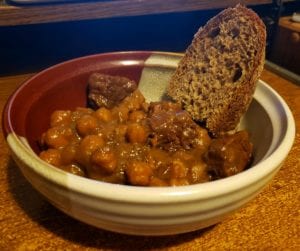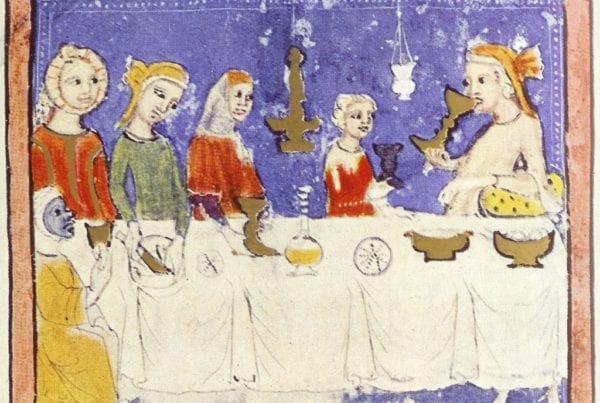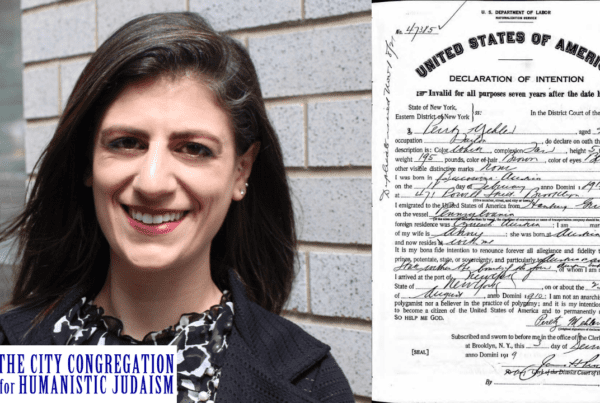
On January 22nd, 2021, we had the honor and pleasure of having a City Congregation member present: Gavin Skal, who was gracious enough to allow us to share a recording of his presentation.
As we say each week, food “signifies sharing, fellowship, and coming together”. But as a prominent part of any culture, what and how we eat can also set us apart. For Jews, the most obvious example of this is Kashrut, though there are a number of other ways that food can signify or imply Jewishness. This was was tragically true for the Jews and Conversos of Late Medieval Iberia, as evidenced by the myriad dietary practices attested to in the documents of the Spanish and Portuguese Inquisitorial Courts.
In this program, Gavin Skal explores the methodology of recreating historical cooking without direct documentation, discusses the role of food during the Spanish Inquisition, and explains how the differences deemed noteworthy by courts can help us to reconstruct meals from the period. He will demonstrates a recipe from the book “A Drizzle of Honey – The Lives and Recipes of Spain’s Secret Jews” by David M. Gitliz & Linda Kay Davidson.
Gavin Skal is a member of our congregation, as well as a member of the Society for Creative Anachronism (https://www.sca.org/), a not-for-profit educational group dedicated to the recreation of life and activities from pre-17th century cultures. Within the SCA, Gavin is known as Perez ben Meir Gershon Effendi, a mid-16th century Sephardic man from the Greek city of Salonica in the Ottoman Empire. His primary interests in the Society are historical cooking, using recipes from a wide array of cultures and periods, and armored combat, where he fights with sword and shield in the tournament field.
If you’d like to cook at home, you can find additional cooking instructions below the video.
Watch a recording of his presentation:
Gavin was kind enough to share with us a picture of the cooked dish as it looked the next morning:
The following are instructions for those wishing to cook at home. This reconstruction of a late 15th-century Sabbath stew (known as Adafina, Hamin, or Ani, among myriad other terms) is adapted for a modern American kitchen. This recipe typically serves 4, and should keep fine in the refrigerator.
Note: This dish is intended to be eaten the day after it is prepared, and will NOT be ready to eat for dinner the evening it is cooked! It will, however, make for a lovely meal the next day.
As time is a key factor for this dish, which is meant to cook slowly overnight, some steps will have to be completed both before the start of the program and after it concludes. During the program itself, Gavin demonstrated the middle steps, which require the most activity but are still simple and straightforward. For greatest ease, he has broken down the steps you will need to do before you start, as well as the steps required to finish the dish, so that you can successfully cook along from home.
Ingredients
• 1 lbs stewing beef, cut into 1-inch chunks
• 8 Tbsp salt
• 1 cup dried chickpeas
• 3 Tbsp olive oil
• 2 cloves garlic, diced
• 2 medium onions, sliced into eighths
• 1 cup (approx) water or broth
Spice Mixture*
• 2 tsp ginger
• 1/4 tsp galangal (galingale)
• 1/8 tsp cloves
• 1 tsp cinnamon
• 1 tsp black pepper
• 1 tsp nutmeg
• 1 tsp grains of paradise
• 3 Tbsp white sugar
*All spices should be ground for this recipe. You can use pre-packaged ground spices, or grind them fresh from whole spices for greater potency. This mixture is typical of one found in many Western European recipes of the Middle Ages, and contains some spices that can be harder to find in modern American grocery stores. I recommend placing an order with Kalustyan’s (https://foodsofnations.com/), which has excellent selection and customer service. If you do so, please be sure to allow enough time for shipping.
Equipment Needed
• Stove top with at least 1 working burner, and a pan
• A conventional oven plus a medium-sized ovenproof stewpot with lid (alternatively, a crockpot/slow-cooker)
• Bowls for soaking meat and mixing spices
• Knife and cutting board
• Sieve
• Wooden cooking spoons
• Oven Mitts
Before cooking
These are the steps you will need to have completed before the demonstrated stages. I have included suggested times for each step in the process to help you plan and stay on track.
1) 3 hours before the demo, soak beef along with 2 Tbsp of salt in just enough water to cover it. Change the saltwater every 45 minutes, for a total of 4 soakings. After the last soaking, drain the meat and lightly rinse away excess salt.
2) 2 hours before the demo, prepare the chickpeas: Wash them and place them in a pan. Cover with water and bring them to a boil for 1 minute. Remove from heat and set aside for 1-1.5 hours, then drain.
3) At your convenience, prepare the other ingredients: Grind (as necessary) and blend the spices, chop the onions, and dice the garlic.
After the demo
Follow these instructions (according to the cooking method you’re using) after the demo concludes to finish the dish. Keep an eye on the liquid in the pot and add more as necessary (just enough to cover) to prevent drying out . You may wish to stir occasionally, scraping the bottom of the pot, to prevent ingredients from sticking.
Oven Method
After 2 hours in the oven at 300°F, reduce temperature to 250°F and continue to cook until ready to serve, at least 7 hours, until the meat becomes extremely tender and falls apart easily.
As it will be cooking overnight, you may wish to turn off the oven for safety reasons before going to bed. If you do so, be sure that the pot remains in the oven with the lid on and the oven closed before it is turned off, to maximize heat retention, and return it to temperature slowly upon rising in the morning, until it is time to serve.
Crockpot/Slow-Cooker
Keep covered, with an eye on the contents, reducing heat if the liquid begins to boil. Reduce to the lowest setting before retiring for the evening, and continue to cook until ready to serve the following day.
To see upcoming events or watch them live, check out our calendar




